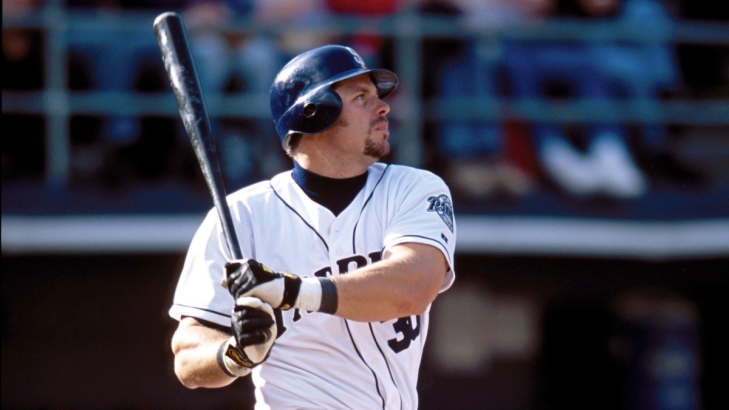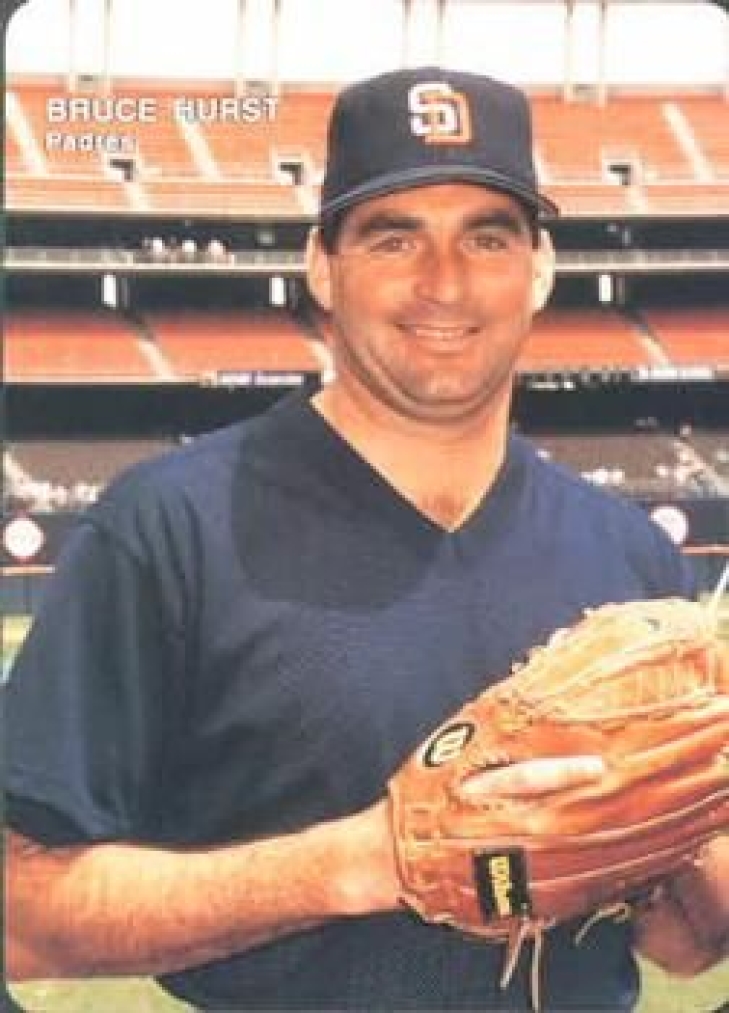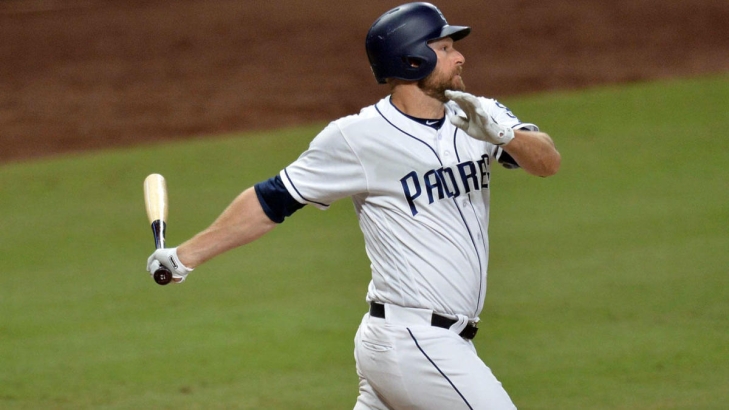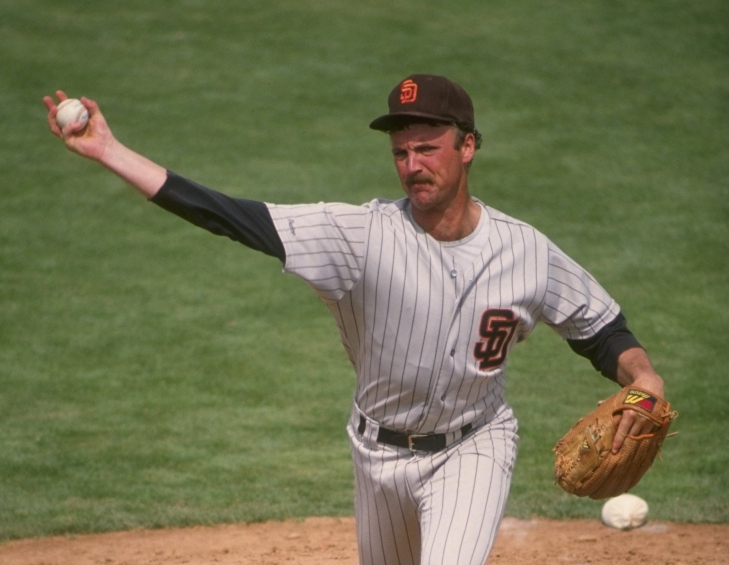39. Bip Roberts
A Rule 5 Draft Pick from Pittsburgh, Bip Roberts had to stay with the Padres for the entirety of the 1986 Season, where he was used mostly out of the dugout as a Pinch Hitter, Pinch Runner, or defensive Replacement. He returned to the Minors over the next two years, returning as a starter in 1989.
Roberts batted .301 in 117 Games in 1989 and had his best year with San Diego the year after, batting .309 with 172 Hits and 46 Stolen Bases. After a down year, Roberts was traded to Cincinnati but would return as a Free Agent in 1994 for two more years before being traded again to Kansas City.
With the Padres, Roberts stole 148 Bases, had 673 Hits, and batted .298.
45. Rollie Fingers
The Oakland Athletics were the team of the early 70s, but they went into a cost-cutting mode in 1976, jettisoning their stars through various methods. One of those players was Rollie Fingers, one of the most influential closers in baseball history and the owner of the most iconic mustaches in sports.
Fingers signed with San Diego after the aforementioned bicentennial year and remained a top closer. A Padre for four years, Fingers was named the National League Rolaids Reliever of the Year in three of them, led the league in Saves twice, and compiled 108 Saves in total with San Diego.
Fingers was traded to St. Louis after the 1980 Season and was traded four days later to Milwaukee, where he won the Cy Young and closed off his career. The Baseball Hall of Fame called his name in 1992.
31. Ozzie Smith
Ozzie Smith would become one of the most dynamic Shortstops in history and an eventual Hall of Fame inductee with a St. Louis Cardinals cap on his plaque. Many forget that his career began in San Diego, and realistically, he was not yet what he would become.
Smith debuted in the Majors with the Padres in 1978 and was the runner-up for the Rookie of the Year, batting .258 with 40 Stolen Bases. This was the best offensive season for Smith as a Padre, but he quickly became an elite defender. Smith won the Gold Glove in 1980 and 1981, leading the NL in Defensive bWAR in 1980 and was second in 1979.
As good as Smith was, the Padres were considered about his bat and traded him to St. Louis for another Shortstop, Garry Templeton. With all due respect to Templeton, Smith's post-trade career blew away Templeton, as Smith maintained his defense and developed his offense, which Padres management likely thought was impossible. Smith only batted .221 with sub-.300 stats in OBP and Slugging; the main reason that the Hall of Famer is ranked so low.
38. Kevin McReynolds
Kevin McReynolds began his career with the Padres, debuting in 1983, the same year he won the Pacific Coast League MVP.
From 1984 to 1986, McReynolds was a starting Outfielder for the San Diego, who was defensively excellent. He twice led the NL among Outfielder in Range Factor per Game and was the 1984 league leader in Total Zone Runs. Offensively, McReynolds had a low OBP, but his bat had pop, belting 65 Home Runs over his time in San Diego with an OPS of .790.
McReynolds was traded to the Mets after the 1986 Season, where he would later win a World Series Ring.
35. Mark Davis
Debuting in 1980 for the Philadelphia Phillies, Mark Davis did not turn any heads until he was traded to the San Diego Padres during the 1987 Season (when he was with San Francisco). Davis finished the second half of that year better than he did as a Giant, but it was nothing compared to what was to come.
Davis ascended to the Padres closing role, and he saved 28 Games with a 2.01 ERA in 1988 while going to the All-Star Game. He had an even better 1989, and with all respect to Trevor Hoffman, Davis had one of the best seasons of any Relief Pitcher in Padres history. Davis was an All-Star again, and he led the NL in Games Finished (65), Saves (44), and WPA (5.8). He won the National League Cy Young Award, making Davis one of the few relievers to win that honor.
Davis' contract had expired, and he signed with Kansas City, but he was never the same Pitcher again. He returned to the Padres during the 1993 Season but was ineffective and was released early the year after. Davis' shine was brief, but it existed, and the Padres fans should never forget it.
6. Manny Machado
Manny Machado was a star in Baltimore, and later the Dodgers, who acquired him for their 2018 playoff run. The Padres changed their usual course, went after, and got Machado as a Free Agent for 2019, and as of this writing, he is still a Padre.
Machado had a solid debut year for San Diego, blasting 32 Home Runs, though his OPS was a little under .800. His second year, the COVID-impaired 2020 Season, saw Machado finish third in MVP voting and gain his first Silver Slugger.
A trendy pick to win the World Series in 2021, the Padres imploded, though Machado again had a good year, returning to the All-Star Game with a 29 Home Run/106 RBI season with an OPS of .836. San Diego would make the postseason in 2022, with Machado having a spectacular year, finishing second in MVP voting with a 32 HR/109 RBI year. In 2023, Machado slipped a bit with 30 Home Runs and a .782 OPS, and the year after he had 29 Home Runs, 105 RBIs, and captured his second Silver Slugger as a Padre.
Machado enters 2025 as one of the top players in baseball.
29. Heath Bell
Heath Bell played for the New York Mets for three years before being traded to the Padres after the 2006 Season. It proved to be a fantastic opportunity for Bell, and eventually, some of the biggest shoes for a reliever to ever fill.
Bell worked his way up to become Trevor Hoffman's setup man. Hoffman signed with the Brewers in 2009, and Bell was given the closer's role, and he rose to the occasion. From 2009 to 2011, Bell was one of the top Relief Pitchers in Baseball, recording at least 42 Saves, and going to the All-Star Game in all of them. He won versions of the Reliever of the Year in 2009 and 2010, with an eighth-place Cy Young in 2010.
Like Hoffman, Bell left San Diego for free agency, but he never had a good year again unlike Hoffman. Bell finished 194 Games, saved 134, and had a 2.53 ERA for the Padres.
26. Joey Hamilton
Joey Hamilton was a highly sought-after commodity in the 1991 Amateur Draft, and he was taken eighth in the draft by San Diego, a minor surprise as, according to Hamilton, they never showed any interest.
Hamilton first made the Padres in 1994, winning nine Games with a 2.98 ERA and finishing fifth in Rookie of the Year voting. Notably, he was seventh in bWAR for Pitchers and again in 1995, despite his losing record (6-9). Hamilton received a lot more run support and won 40 Games over the next three years, even though his ERA was now over four, and his WHIP inflated to over 1.300. He was still a decent starter, and he aided them in winning the National League Pennant in 1998, though San Diego was dismantled by the Yankees.
Hamilton was traded to the Toronto Blue Jays following the World Series, ending his Padres career. He would have a 55-44 Record with a 3.83 ERA and 639 Strikeouts.
22. Ryan Klesko
A World Series Champion with the Atlanta Braves in 1995, Ryan Klesko was traded to the San Diego Padres before the millennium. Klesko was a decent power hitter with the Braves, and that is what he continued as a Padre.
In the first two seasons with San Diego, Klesko continued his Home Run hitting with 26 and 30 respectively, but had 23 Stolen Bases in both years, an astounding achievement considering his previous high was six. Klesko also went to his first All-Star Game that year. Klesko had another two years with over 20 Home Runs but afterward began to miss games due to ailments and lost a bit of bat speed.
After missing nearly all of 2006 due to a shoulder injury, he signed with San Francisco as a Free Agent but retired after an unproductive season. He smacked 133 Home Runs with the Padres, had 786 Hits, and batted .279.
23. Bruce Hurst
An All-Star with the Red Sox in 1987, Bruce Hurst signed with the Padres as a Free Agent after the 1988 season, bringing with him a decade of experience and a proven arm.
Hurst played for San Diego for a little over four years, and his output off of the mound was similar to what he gave Boston. Hurst led the National League in Complete Games (10) in 1989, winning 15 against 11 Losses, with a career-best 2.69 ERA. The southpaw continued to have good years, winning 40 Games from 1990 to 1992, and with the exception of '92, he kept his WHIP under 1.200.
Shoulder problems and eventual surgery crippled his 1993 season, though he was traded during it. Hurst only played another year but was never the same. He might be best known for his work in Boston, but his 55-38 record with the Padres was a decent haul.
30. Garry Templeton
Garry Templeton will always be best known for being traded for fellow Shortstop Ozzie Smith. There were other players involved in the deal, but the swap of Shortstops would be the focal point, especially since Smith became a Hall of Famer.
Templeton had a good career, but not in the stratosphere of Smith, and nor was he ever as good in San Diego as he was in St. Louis. A Padre for ten years, Templeton did go to an All-Star Game, and won a Silver Slugger, and collected 1,135 Hits with a .252 Batting Average. A four-year captain of the team (1987-91), Templeton’s rank is hampered by his sub-.300 OBP, and lack of power, but he should not always be compared to Smith.
The Padres inducted Templeton into their Hall of Fame in 2015.
24. Greg Harris
A quick look at the stats of Greg Harris does not make you think that he belongs on this list, at least this high, but that is why statisticians provide much deeper looks than just a Winning Percentage.
Harris debuted for the Padres in 1988, appearing in three Games, before settling into a bullpen role in the next two seasons. Harris threw for over 110 Innings in each of those years, mainly in a set-up capacity, and he posted an ERA well under three.
San Diego moved Harris back to the starting rotation in 1991, and while injuries held him to only 20 Games, he made the most of it, winning nine and posting a 2.23 ERA. Harris slipped in 1992, with his ERA going over four, but he was righting the ship in 1993, winning 10 Games with a 3.67 ERA before he was traded to Colorado.
Harris had a 2.95 ERA with a 41-39 Record and 462 Strikeouts with the Padres.
20. Phil Nevin
One of the more versatile players that the Padres ever had, Phil Nevin played a bounty of Games for San Diego at Third, First, Rightfield, and at Catcher, but it looked for a while like Nevin would never become an everyday player in the Majors.
Nevin was a former Number One Pick, taken by the Astros in 1992, but they soured on him, and he was traded to Detroit in 1995, and two years later to Anaheim, with neither place seeing Nevin ascend to an everyday player. The Angels sent him south to San Diego, and finally, he began to meet expectations.
Nevin had 24 Home Runs in 1999 and increased it to 31 in 2000, where he also had his first .300 season, with a .303 Batting Average. He followed that with the best season of his career, with career highs in Hits (167), Home Runs (41), RBIs (126), and the three Slash Line components (.306/.388/.588). Bevin was an All-Star that year, was 21st in MVP voting, and had his third consecutive year with a Slugging Percentage over .500.
Nevin was injured through most of the 2002 and 2003 seasons, and he had a nice comeback year in 2004 (26 HR, 105 RBI, .289 BA), but he was getting older and was deemed expendable. He was traded to Texas during the 2005 Season, leaving San Diego with 156 Home Runs, 573 RBIs, and had a Slash Line of .288/.359/.503.
19. Brian Giles
Brian Giles was an underrated baseball player, amassing 1,897 Hits over his career, 872 as a Padre, the team he played his last six years and change with to close out his career.
Giles was traded in late August 2003 from Pittsburgh, where he was a two-time All-Star. The Outfielder still had a lot left, and over the next three years, he secured at least 159 Hits, the best season being in 2005, where he led the NL in Walks (119), batted .301, and his .423 OBP was third in the NL. Notably, he was ninth in MVP voting, his highest finish. Giles still had respectable power, belting 83 Home Runs with San Diego.
Giles' career fell off in 2009, and he signed with the Dodgers as a Free Agent but would not make the team. He would have a Slash Line of .279/.380/.435 with San Diego.
21. Eric Show
Save for the last season of his career when he played for Oakland, Eric Show played his Major League career with the San Diego Padres, where he mainly played as a member of their rotation for a decade.
Show debuted in 1981, and by 1983, Show was a fixture of the Padres starting staff. He would post back-to-back 15 Win seasons in 1983 and 1984, with the latter year seeing San Diego win the Pennant. Show remained a middle-of-the-rotation guy for San Diego until 1990, never going to the All-Star Game, but always a serviceable asset.
Show would be a controversial figure in the clubhouse, not always popular due to his mood swings and far-right political leanings. He also gave up Pete Rose's record-breaking 4,192 Hit, and he was not lauded for the way he stood cross-armed at the mound. Show also struggled with substance abuse and would die at the age of 37 from an overdose three years after retiring from baseball.
While he was not a spectacular hurler, his longevity with the Padres allowed him to be the franchise leader in Wins (100) and had 951 Strikeouts with a 3.59 ERA.
17. Chase Headley
A star at the University of Tennessee, Chase Headley parlayed his run as a Volunteer to a Second Round Pick in the 2006 Amateur Draft. Headley would make it briefly to the Majors (with San Diego) the following season.
Headley began 2007 in the Minors, but by June, he was back in San Diego and would become a starter before long. Headley showed gradual improvement over the next four years, first playing in Leftfield but moving to Third Base, where he played most of his career. In 2012, Headley would have the season of his life, posting career-bests in Home Runs (31), RBIs (115), and OPS (.875) while winning the Gold Glove, Silver Slugger, and the RBI Title. Headley was also fifth in MVP voting, the only year he ever received a vote.
After slipping back to his regular production in 2013, Headley was traded mid-year in 2014 to the Yankees. New York would send him back after the 2017 Season, and Headley played back in San Diego briefly before he was released in May.
With the Padres, Headley contributed 87 Home Runs, 879 Hits, and batted .263.
18. Ed Whitson
Ed Whitson played eight of his 15 seasons with the San Diego Padres, over two stints, he first a two-year run from 1983 to 1984.
Whitson, who first joined San Diego from a trade from Cleveland, struggled in 1983, with a 4.30 ERA and 5-7 record, but he had a much better season in 1984, winning 14 Games against 8 Losses and reducing his ERA to 3.24 with a 1.180 WHIP. He signed with the Yankees as a Free Agent the following year but returned midway through the 1986 Season.
Whitson did not have a good return, finishing the year with an abysmal 1-7 record and a ballooned ERA (5.59). 1987 was marginally better, but he had a solid 1988 (13-11, 3.77), and over 1989 and 1990, the junkball Pitcher had ERAs under three, a winning record (30-20), and led the NL in bWAR for Pitchers in 1990 (7.0). That was Whitson’s last productive year in Baseball, as he regressed in 1991, and at age 36, was out of the sport.
Whitson had a 77-72 Record with a 3.69 ERA with the Padres.
16. Benito Santiago
Benito Santiago played for nine teams over his 20 years in the Majors, and this might make him seem like he was a journeyman. That might be what he became, but when his career began in San Diego, he was considered by many to be the best young Catcher in Baseball.
The Puerto Rican was signed in 1982 and debuted for the Padres four years later, appearing in 17 Games, thus keeping his rookie eligibility for the following year. That allowed Santiago, who took over as the starting Catcher, to win the Rookie of the Year, and he arguably had his best offensive season as a Padre. Santiago batted .300 and 18 Home Runs and won the Silver Slugger, an award he repeated three more times with San Diego.
Santiago was universally praised for his defense, and offensively, he never had less than 10 Home Runs in any of his seasons with the Padres. An All-Star each year from 1989 to 1992, Santiago also won three straight Gold Gloves (1988-90) and finished in the top ten in Defensive bWAR three times.
Following the 1992 Season, Santiago joined the expansion Florida Marlins, leaving them with 758 Hits, 85 Home Runs, and a Defensive bWAR of 8.9.
While Santiago was a popular figure in San Diego, it is hard to rank him any higher as he had a sub-three OBP with the Padres, and while he was praised for his defense, he was at times error-prone.
7. Fernando Tatis Jr.
As of this writing, Fernando Tatis Jr. has only been with the San Diego Padres for four seasons, but he is one of the most exciting players in the game and has so much more ahead of him.
The Chicago White Sox first signed the son of a 14-Year veteran, Fernando Tatis, Tatis Jr. as an Amateur Free Agent in 2015, but before he played an organized game in the ChiSox organization, he was traded to the Padres in a move that will haunt White Sox for years to come. Tatis Jr. climbed up the Padres organization, making the Friars in 2019, finishing third in Rookie of the Year, voting off a .317, 22 HR year.
COVID-19 ravaged 2020, but not Tatis Jr., who emerged as one of the best players in the NL. He finished fourth in MVP voting, won the Silver Slugger, and the Shortstop batted .277 with 17 Home Runs in 59 Games. 2021 was better, as Tatis Jr. led the NL in Home Runs (42) with 97 RBIs and a Slash Line of .282/.364/.611. Tatis Jr. won his second Silver Slugger, was third in MVP voting, and, as he did in 2020, was named to the All-MLB 1 Team. The sky should have been what Tatis reached in 2022, but that was not to be, as he started the season on the disabled list and ended it with a drug suspension, leaving him with zero Games Played in 2022. He began 2023 serving the rest of his suspension, and a lot of question marks were ahead of him, but he returned as San Diego's best player and an All-Star snub. Tatis had 25 Home Runs, and had his best defensive year to date, winning a Gold Glove with a 2.3 Defensive bWAR.
Coming off an injury-riddled 2024 season, what will 2024 bring for Tatis Jr?
8. Andy Ashby
Andy Ashby was traded during his third Major League Season from the expansion Colorado Rockies in 1993 to San Diego, and it was as a Padre where Ashby shone brightest.
The Righthanded Pitcher, who arrived as the "player to be named later," finished off '93 better than in Colorado, though considering he had an 8.50 ERA with the Rockies, that did not say much. Ashby was much better in 1994 (6-11, 3.40 ERA), but in 1995, he cemented himself as a valuable part of the Padres staff, with a 12-10 Record and a 2.94 ERA.
Ashby had respectable years in 1996 and 1997 but broke out with All-Star seasons in 1998 and 1999 and was undoubtedly the staff ace. These two years landed Ashby so high on this list, but it also led to his trade, as the small market Padres traded him to the Phillies before the 2000 Season.
Ashby had a 70-62 Record and 829 Strikeouts with the Padres.





















